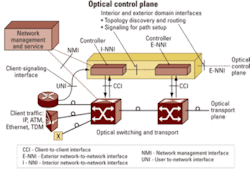Optical control plane will rewrite the rulebook
Fundamental dislocation is under way in the optical network. As a matter of priority, service providers are looking beyond today’s clunky service delivery model, with its reliance on manual provisioning and long-term bandwidth allocation, to a next generation network architecture capable of intelligent capacity utilization, automated delivery of value-added services, and on-demand circuit provisioning. Underpinning that vision is the realization of a unified optical control plane that will enable service providers to create, manage, and troubleshoot optical services end-to-end.
Initiating such large-scale transformation is far from straightforward. New standards for the optical network as well as changes to existing transport and switching hardware platforms are going to be essential. Several organizations have been working on these developments, namely the International Telecommunication Union’s standardization sector (ITU-T), the Internet Engineering Task Force (IETF), and the Optical Internetworking Forum (although the OIF is not a standards-making organization, rather a group that works with its members to define practical ways to deploy interoperable optical-network elements).The IETF, for its part, has introduced GMPLS-basically a suite of protocols that in effect “copy and adopt” packet-based MPLS methods from the IP domain to the optical domain. Two key protocols being adopted are the constraint routing-link distributed protocol (CR-LDP) and resource reservation protocol-traffic engineering (RSVP-TE). Based on the signaling and routing protocols of the GMPLS optical control plane, the various network elements (NEs) of an optical network can communicate and work with each other. Among these elements might be SONET/SDH gear, DWDM equipment, or switching units (wavelength-, fiber- or time-division multiplexing). The ITU-T, meanwhile, is driving the optical switching requirements via the Automatic Switched Optical Network (G.ASON, G.8080), while the OIF is taking care of the user-to-network and network-to-network interfaces (UNI/NNI).
The optical control plane ensures the connection between the MPLS electrical domain (routing, Ethernet Layer 2/3 switches, etc.) and the underlying optical transport and switching domain, also called the optical transport network (OTN). Key elements of the optical control plane are the connection controller (for the establishment and creation of connections), the routing controller (for provision of routing information to the connection controller), link resource manager (link allocation), traffic policing (to assure compliance between forwarded traffic and the respective service-level agreement [SLA]), and the network call controller (for control of the client network connection).
On the basis of these technologies, the optical control plane provides a number of operational advantages in service-provider networks, including:
• Flexible network architectures for rapid provisioning of the required connections alongside rapid restoration mechanisms.
• Dynamic and efficient bandwidth allocation, which enables service providers to offer their customers differentiated services (SLAs) and rapid turnup.
• Resource tracking and allocation as well as detailed network-control information (inventory, topology, etc.).
• Vendor interoperability.
As the optical control plane forms part of the IP and transport network architecture-better still, combining both the electrical-IP domain and optical-transport domain-it is typically being implemented by service providers and (mostly incumbent) carriers in a step-by-step manner. This hybrid approach is driven by a balance of technical and commercial needs. But what does that mean in real world terms? The Table summarizes the potential steps for a carefully staged implementation with the best continued usage of the existing network management and operational support systems (NMS/OSS) in mind.
Today’s traditional networks are static and rather inflexible systems; capacity planning is a slow and non-dynamic process, protection circuits must be predefined, and equipment interoperability between various vendors is an ongoing headache. The upgrade to enhanced transport equipment compliant with the latest OTN requirements will be the first step toward an intelligent optical network built upon an optical control plane. In fact, this approach is already ensuring reduced capital and operational expenditures, while yielding optimized connection provisioning times.During step 2, the NMS and OSS are also enhanced, which in turn allows the introduction of the optical control plane and its control of the underlying OTN in step 3. In this way, the transition is almost completed, all hardware structures are in place, and customers are seeing the first changes in the service offering. What’s more, the service provider can offer price-competitive services in combination with tailored SLAs that range from best-in-class network security with minimum restoration times to lowest-cost best-effort services.
Independent from the processes described above, service providers can implement various models of the optical control plane:
• In the peering model, all NEs represent a peer, sharing the topology information and thus making it available to the connected clients. The cost reduction is maximized and network operation vastly simplified.
• The overlay model is closer to today’s way of operating transport networks. The control plane is segmented into an IP domain and optical domain; the router is a client of the optical domain and has no knowledge of the optical topology.
A hybrid implementation of both the peering and overlay model is also possible. In this case, the service provider will set up a peering model for the internal network while deploying an overlay model for the customer networks.Today’s networks are on the move toward an optical control plane model, with many equipment manufacturers adopting the ITU-T and IETF recommendations. Although comprehensive implementation of an intelligent optical control plane is still in the future, especially in terms of full vendor interoperability, a number of service providers have already started to put the basics in place (i.e., step 2 of the implementation scenario described in the Table). Most of these early adopters have a need for flexible data/voice and transport networks. For example:
• One of more advanced implementations is the DANTE (Delivery of Advanced Network Technology to Europe) GÉANT2 network, spanning several European research centers in Germany, France, the United Kingdom, the Netherlands, Spain, Austria, Italy, Switzerland, Hungary, Slovenia, Poland, Ireland, Greece, Portugal, and Croatia. By the time it is completed, 34 countries will be connected via a network operating with a distributed GMPLS-based optical control plane. Broadband IP services are supported by direct optical connectivity to the preexisting IP network.
• In France, n9uf telecom operates an 11‑000‑km network spanning more than 60 cities. The optical backbone network provides wavelength services as well as managed bandwidth and optical virtual-private-network (VPN) services. Again, a mesh infrastructure provides resilience and the scope for future growth.
• Vodafone UK represents one of the bigger service providers working toward the intelligent optical network. With about 40 nodes, the optical switched network established by Vodafone UK supports both wireless voice and data services. The mesh restoration service is one of the key features of the network.
The above deployments are all based on single-vendor equipment. Elsewhere, however, a series of ambitious demonstrations carried out over the past year indicates that encouraging progress is being made in multivendor deployments. In September 2004, for example, the University of New Hampshire hosted an experiment involving NTT (Japan’s leading carrier) and manufacturers of optical and data networking gear, including Juniper Networks, Navtel Communications, Agilent Technologies, Sycamore Networks, and Tellabs. Objectives included bandwidth on demand, multilayer cut-through, GMPLS traffic engineering capabilities, and open shortest path first-traffic engineering (OSPF-TE). The test demonstrated successful dynamic provisioning of Layer 1 VPNs in a multivendor environment.
A more ambitious trial was carried out by the OIF at SuperComm last June. The participants included incumbent carriers like Deutsche Telecom, AT&T, France Telecom, China Telecom, and Telecom Italia; participating equipment vendors included Avici, Alcatel, Ciena, Cisco Systems, Fujitsu, Huawei, Lucent Technologies, Marconi, Nortel Networks, Sycamore, and Tellabs. The experiment successfully demonstrated the worldwide interoperability of the dynamic end-to-end connection management between client devices and multivendor OTN elements.
By stitching together a demonstration system consisting of multiple domains in a multinode global transport network, the test was aimed at the delivery of Ethernet virtual services and dynamically controlled Ethernet private-line services over the SONET/SDH optical network. The connections were established by the optical control plane, bridging the Ethernet layer as well as the transport-network layer and responding to requests for DBA. Additional optical paths were automatically configured in accordance with the bandwidth requirements specified via the UNI call request.
The optical control plane and its related technologies like next generation SONET/SDH, GMPLS, and ASON provide significant advantages to both end customers and service providers. While customers benefit from broadband end-to-end services and optical VPNs-mostly based on Ethernet-the service providers realize significant gains in terms of the flexibility of their networks, enhanced SLAs, DBA, and increased resilience.
The future looks bright. The first GMPLS-based networks have been implemented, although the intelligent optical network, with its UNI-driven dynamic allocation of resources, is still more the objective rather than the reality. At the same time, initial multivendor demonstrations have been completed earlier this year, with real world issues like billing or link management protocols to be addressed in the next phase of development.Volkmar Kaufmann is marketing manager of optical and Ethernet products, Europe, Middle East, and Africa, at Intel. This article appears courtesy ofFibreSystems Europe in Association with Lightwave Europe, July/August 2005, p. 16.




